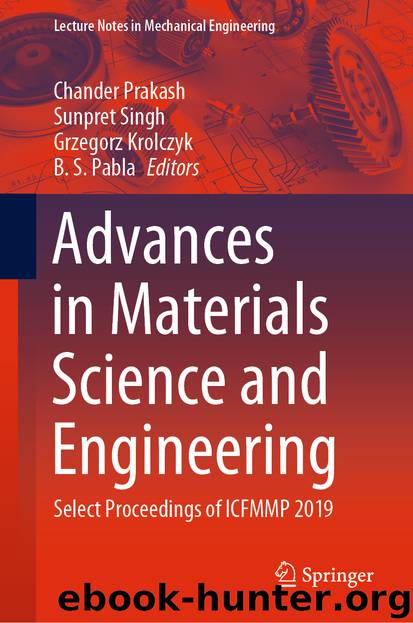Advances in Materials Science and Engineering by Unknown

Author:Unknown
Language: eng
Format: epub
ISBN: 9789811540592
Publisher: Springer Singapore
Friction stir processing (FSP) is a new kind of solid-state composite processing technique that originated from friction stir welding process. It carries out localized microstructural refinement by plastically deforming the material and not melting them, thus leading to dynamic recrystallization. The resulting material has improved, refined and homogeneous microstructure in the stir zone. This is achieved by employing a rotating tool consisting of a shoulder with pin structure of desired dimensions. The rotating tool is impinged into the surface of material such that only the pin gets dipped into the material and the shoulder only touches the surface providing downward locking force. The friction between the rotating pin and the contact surface of material led to generate high temperature which results in plastic deformation of the material. This is followed by slow and steady translation of the tool along specified direction. If the material is reinforced with fine nano-powders of additives, it will help evenly and homogeneously distribute the additives in the material, thus forming a composite structure. The controllable process parameters which are used in FSP are tool geometry, tool rotation speed, translation speed of the tool, tool tilt angle, axial downward force and number of passes [16–18].
Huang et al. [19] were studied that the addition of carbon nanotubes (CNTs) in Mg-6Zn composites enhanced the grain refinement as well as mechanical properties such as yield strength, ultimate tensile strength; elongation was drastically improved as compared with base alloy. Lim et al. [20] had fabricated aluminium alloy/multi-walled carbon nanotubes through friction stir processing. Scanning electron microscope (SEM) and transmission electron microscope (TEM) micrographs were indicated that the nanotubes are uniformly dispersed into aluminium alloy matrix at the stir zone. The mechanical properties also depend upon the microstructure of the composites. Jamshidijam et al. [21] investigated the microstructural characterization as well as mechanical behaviours such as microhardness and wear properties of the multi-walled carbon nanotubes reinforced into magnesium alloy (AZ31) composite fabricated via friction stir processing. The composites materials exhibited higher microhardness as well as superior resistance to wear compared to as-received alloy. This is because of uniformly dispersion of reinforced material as well as fine grain of matrix. Morisada et al. [22] prepared surface composite by reinforcing CNTs into AZ31 Mg alloy and found it to generate grain refinement and almost twofold increase in the hardness. Singh and Pal [23] were successfully fabricated Al metal matrix composite by incorporating the tailored SiC particles via friction stir processing. Morphology of SiC was changed via addition of MgO as well as nanocrystalline MgAl2O4 spinel through sol–gel process. It was concluded that ultrafine equiaxed grains were found after FSP. Mechanical properties of the composite materials were significantly improved after FSP. Izadi et al. [24] had investigated uniformly distribution multi-walled carbon nanotube at high-volume fraction (>50%) into aluminium matrix fabricated through multi-pass friction stir processing. SEM and TEM micrographs had confirmed the uniform dispersion of reinforcement. The microhardness of composites showed two times higher than the as-received aluminium alloy. Zhou et al. [25] were studied the thermal expansion response of aluminium/multi-walled carbon nanotube (MWCNT).
Download
This site does not store any files on its server. We only index and link to content provided by other sites. Please contact the content providers to delete copyright contents if any and email us, we'll remove relevant links or contents immediately.
Kathy Andrews Collection by Kathy Andrews(11765)
The remains of the day by Kazuo Ishiguro(8892)
Spare by Prince Harry The Duke of Sussex(5140)
Paper Towns by Green John(5138)
The Body: A Guide for Occupants by Bill Bryson(5027)
Industrial Automation from Scratch: A hands-on guide to using sensors, actuators, PLCs, HMIs, and SCADA to automate industrial processes by Olushola Akande(5024)
Machine Learning at Scale with H2O by Gregory Keys | David Whiting(4259)
Be in a Treehouse by Pete Nelson(3996)
Never by Ken Follett(3884)
Harry Potter and the Goblet Of Fire by J.K. Rowling(3808)
Goodbye Paradise(3761)
Into Thin Air by Jon Krakauer(3348)
The Remains of the Day by Kazuo Ishiguro(3347)
Fairy Tale by Stephen King(3307)
The Cellar by Natasha Preston(3297)
The Genius of Japanese Carpentry by Azby Brown(3254)
120 Days of Sodom by Marquis de Sade(3226)
The Man Who Died Twice by Richard Osman(3040)
Drawing Shortcuts: Developing Quick Drawing Skills Using Today's Technology by Leggitt Jim(3037)
